High-Fidelity OC-Seislet Stacking Method for Low-SNR Seismic Data
Abstract
1. Introduction
2. Materials and Methods
2.1. Theory of Seislet Stacking
- 1.
- Split the input seismic traces into odd and even trace sequences, denoted as and , respectively, with each pair forming a group.
- 2.
- Based on the predictability of the seismic event, calculate the difference traces between the odd traces and the predicted even traces.The role of the prediction operator in the lifting scheme is to approximate the even traces with the odd traces after prediction. According to the definition of the two-dimensional seislet transform, the prediction operator based on the Haar basis is given bywhere is the prediction operator for converting even traces to odd traces, with the positive and negative signs indicating the forward and backward directions. Fomel [39] provides the specific expression of the trace prediction operator in the time–space–scale domain under the Z-transform. This operator depends on the prediction direction along the seismic event, and represents the data grouping index.
- 3.
- The difference trace is updated using the update operator from the lifting scheme. The updated trace is then added to the even trace to compute the approximate value of the even trace.where the update operator based on the Haar basis is given bywhere is the prediction operator for converting odd traces to even traces. By substituting Equations (1), (2), and (4) into Equation (3), we obtainLet and be the predicted odd and even traces. The approximate trace can be considered as adjusting the data at the same horizontal position and then stacking along the same event direction according toAfter performing the averaging, the number of traces will be half of the original number of seismic traces.
- 4.
- Rearrange the scale coefficients to odd positions on oneself scale, and repeat steps 1–3 for the approximate sequence to effectively achieve NMO stacking. After repeating this process times (where is the number of traces), we obtain the seislet stacking result. We can also observe that, at this stage, seislet stacking is equal to traditional equal-weight stacking, except it uses partial moveout through iterative computations.
2.2. High-Order OC-Seislet Stacking
- First of all, convert the pre-stack seismic data into CMP gathers. NMO is applied to reduce the horizontal time shift, where the correction error caused by inaccurate velocity analysis is allowed.
- Second, apply logarithmic stretching to the time axis, followed by Fourier transforms along the time () and space () directions.
- Third, perform OC-seislet stacking using the OC operator and high-order CDF 9/7 transform coefficients, normalize the weighting coefficients, and apply soft-thresholding for further denoising. OC-seislet operators are able to correct the NMO error in the first step with the help of high-order coefficients.
- Finally, apply the inverse Fourier transform along the and directions, followed by the inverse logarithmic transformation along the time axis, and obtain the OC-seislet stacking result in the time–space domain.
3. Results
3.1. Synthetic Model Data Tests
3.2. Field Data Tests
4. Conclusions and Discussion
Author Contributions
Funding
Institutional Review Board Statement
Informed Consent Statement
Data Availability Statement
Acknowledgments
Conflicts of Interest
References
- Zhou, Z.; Liu, Y.; Liu, C.; Wang, Q.; Zheng, Z. Attribute of local cosine similarity based on a fast-streaming algorithm. Chin. J. Geophys. 2022, 65, 349–359. (In Chinese) [Google Scholar] [CrossRef]
- Mayne, W.H. Common reflection point horizontal data stacking techniques. Geophysics 1962, 27, 927–938. [Google Scholar] [CrossRef]
- Hale, D. Dip-moveout by Fourier transform. Geophysics 1984, 49, 741–751. [Google Scholar] [CrossRef]
- Judson, D.R.; Schultz, P.S.; Sherwood, J.W.C. Equalizing the stacking velocities of dipping events via Devilish. In Proceedings of the 48th Annual International SEG Meeting, San Francisco, CA, USA, 29 October–2 November 1978. [Google Scholar]
- Jamali, E.; Mikada, H.; Asakawa, E. Developing initial model for seismic full waveform inversion using conventional data processing tools. In Proceedings of the 20th International Symposium on Recent Advances in Exploration Geophysics (RAEG 2016), Chiba City, Japan, 24 May 2016; European Association of Geoscientists & Engineers: Chiba City, Japan, 2016; pp. 1–4. [Google Scholar] [CrossRef]
- Yilmaz, Ö.; Claerbout, J.F. Prestack partial migration. Geophysics 1980, 45, 1753–1779. [Google Scholar] [CrossRef]
- Liner, C.L. General theory and comparative anatomy of dip moveout. Geophysics 1991, 56, 595–607. [Google Scholar] [CrossRef]
- Biondi, B.; Fomel, S.; Chemingui, N. Nizar Azimuth moveout for 3-D prestack imaging. Geophysics 1998, 63, 574–588. [Google Scholar] [CrossRef]
- Black, J.L.; Schleicher, K.L.; Zhang, L. True-amplitude imaging and dip moveout. Geophysics 1993, 58, 47–66. [Google Scholar] [CrossRef]
- Geng, J.; Ma, Z.; Wang, H.; Lei, B. Full wave-equation finite-difference dip moveout. J. Tongji Univ. (Nat. Sci.) 1998, 4, 430–433. [Google Scholar]
- Zucca, M.; Crespi, P.; Tropeano, G.; Simoncelli, M. On the influence of shallow underground structures in the evaluation of the seismic signals. Ing. Sismica 2021, 38, 23–35. [Google Scholar]
- Bolondi, G.; Loinger, E.; Rocca, F. Offset continuation of seismic sections. Geophys. Prospect. 1982, 30, 813–828. [Google Scholar] [CrossRef]
- Bagaini, C.; Spagnolini, U. 2-D continuation operators and their applications. Geophysics 1996, 61, 1846–1858. [Google Scholar] [CrossRef][Green Version]
- Hale, D. A nonaliased integral method for dip moveout. Geophysics 1991, 56, 795–805. [Google Scholar] [CrossRef]
- Deregowski, S.; Rocca, F. Geometrical optics and wave theory of constant offset sections in layered media. Geophys. Prospect. 1981, 29, 374–406. [Google Scholar] [CrossRef]
- Dix, C.H. Seismic velocities from surface measurements. Geophysics 1955, 20, 68–86. [Google Scholar] [CrossRef]
- Geng, J.; Ma, Z. Fast DMO algorithm. Oil Geophys. Prospect. 1994, 29, 462–467. [Google Scholar]
- Wang, C. Dip moveout in the Radon domain. Geophysics 1999, 64, 278–288. [Google Scholar] [CrossRef]
- Biondi, B.; Ronen, J. Dip moveout in shot profiles. Geophysics 1987, 52, 1473–1482. [Google Scholar] [CrossRef]
- Larner, K.L.; Gibson, B.R.; Chambers, R.; Wiggins, R.A. Simultaneous estimation of residual static and crossdip corrections. Geophysics 1979, 44, 1175–1192. [Google Scholar] [CrossRef]
- Nedimović, M.R.; West, G.F. Crooked-line 2D seismic reflection imaging in crystalline terrains: Part 1, data processing. Geophysics 2003, 68, 274–285. [Google Scholar] [CrossRef]
- Mancuso, C.; Naghizadeh, M. Generalized cross-dip moveout correction of crooked 2D seismic reflection surveys. Geophysics 2021, 86, V285–V298. [Google Scholar] [CrossRef]
- Ravve, I.; Koren, Z. Moveout approximation for horizontal transversely isotropic and vertical transversely isotropic layered medium. Part I: 1D ray propagation. Geophys. Prospect. 2010, 58, 577–597. [Google Scholar] [CrossRef]
- Koren, Z.; Ravve, I.; Levy, R. Moveout approximation for horizontal transversely isotropic and vertical transversely isotropic layered medium. Part II: Effective model. Geophys. Prospect. 2010, 58, 599–617. [Google Scholar] [CrossRef]
- Shragge, J.; Lumley, D. Elliptical dip moveout for 3D seismic imaging in the presence of azimuthal anisotropy. Geophysics 2012, 77, C1–C12. [Google Scholar] [CrossRef]
- Notfors, C.; Godfrey, R. Dip moveout in the frequency-wavenumber domain. Geophysics 1987, 52, 1718–1721. [Google Scholar] [CrossRef]
- Bale, R.; Jakubowicz, H. Post-Stack Prestack Migration. In SEG Technical Program Expanded Abstracts 1987; Society of Exploration Geophysicists: Houston, TX, USA, 1987; pp. 714–717. [Google Scholar] [CrossRef]
- Fomel, S. Theory of differential offset continuation. Geophysics 2003, 68, 718–732. [Google Scholar] [CrossRef][Green Version]
- Fomel, S.; Bleistein, N. Amplitude preservation for offset continuation: Confirmation for Kirchhoff data. J. Seism. Explor. 2001, 10, 121–130. [Google Scholar]
- Liu, Y.; Fomel, S. OC-Seislet: Seislet transform construction with differential offset continuation. Geophysics 2010, 75, WB235 –WB245 . [Google Scholar] [CrossRef]
- Liu, Y.; Fomel, S.; Liu, C.; Wang, D.; Liu, G.-C.; Feng, X. High-order seislet transform and its application of random noise attenuation. Chin. J. Geophys. 2009, 52, 2142–2151. (In Chinese) [Google Scholar] [CrossRef]
- Sweldens, W. Lifting scheme: A new philosophy in biorthogonal wavelet constructions. In Proceedings of the SPIE’s 1995 International Symposium on Optical Science, Engineering, and Instrumentation, 1995, San Diego, CA, USA, 9–14 July 1995; pp. 68–79. [Google Scholar] [CrossRef]
- Genovese, F.; Muscolino, G.; Palmeri, A. Effects of stochastic generation on the elastic and inelastic spectra of fully non-stationary accelerograms. Probabilistic Eng. Mechanic. 2023, 71, 103377. [Google Scholar] [CrossRef]
- Zhang, S.; Xu, Y. Higher-order correlative stacking for seismic data in the wavelet domain. Chin. J. Geophys. 2006, 49, 554–560. (In Chinese) [Google Scholar]
- Fomel, S.; Liu, Y. Seislet transform and seislet frame. Geophysics 2010, 75, V25–V38. [Google Scholar] [CrossRef]
- Donoho, D.L. De-noising by soft-thresholding. IEEE Trans. Inf. Theory 1995, 41, 613–627. [Google Scholar] [CrossRef]
- Haldorsen, J.B.U.; Farmer, P.A. Resolution and NMO-stretch: Imaging by stacking. Geophys. Prospect. 1989, 37, 479–492. [Google Scholar] [CrossRef]
- Fomel, S.; Grechka, V. Nonhyperbolic Reflection Moveout of P-Waves: An Overview and Comparison of Reasons; Technical Report CWP-372; Colorado School of Mines: Golden, CO, USA, 2001. [Google Scholar]
- Fomel, S. Applications of plane-wave destruction flters. Geophysics 2002, 67, 1946–1960. [Google Scholar] [CrossRef]
- Hu, P.; Li, W.; Yang, P.-C. The application of the method of reconstruction a phase space with higher dimensions to the study of seismic processes and earthquake prediction. Acta Seismol. Sin. 1993, 6, 931–937. [Google Scholar] [CrossRef]
- Stanescu, D.; Digulescu, A.; Ioana, C.; Serbanescu, A. A Novel Approach for Characterization of Transient Signals Using the Phase Diagram Features. In Proceedings of the 2021 IEEE International Conference on Microwaves, Antennas, Communications and Electronic Systems (COMCAS), Tel Aviv, Israel, 1–3 November 2021; pp. 299–304. [Google Scholar] [CrossRef]
- Daubechies, I.; Sweldens, W. Factoring wavelet transforms into lifting steps. J. Fourier Anal. Appl. 1998, 4, 247–269. [Google Scholar] [CrossRef]
- Sun, W.; Li, Z.; Qu, Y. The 3D conical Radon transform for seismic signal processing. Geophysics 2022, 87, 481–504. [Google Scholar] [CrossRef]
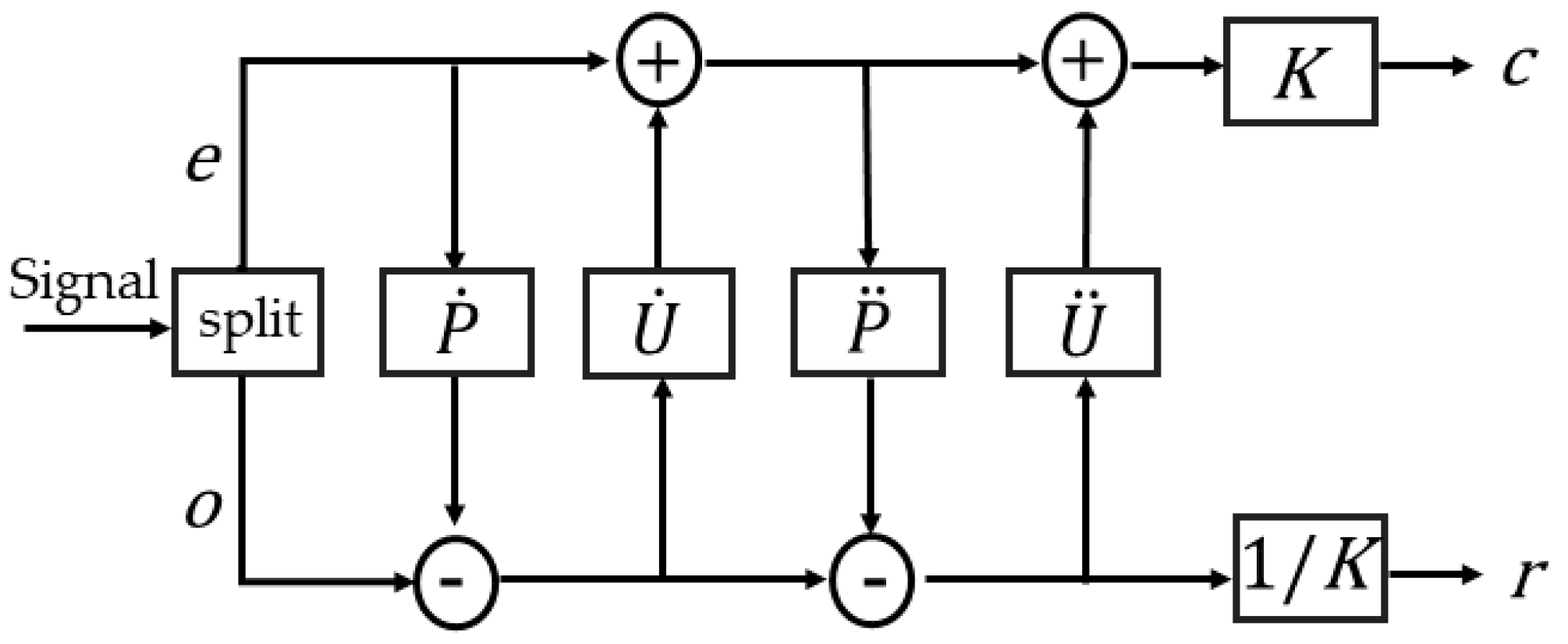
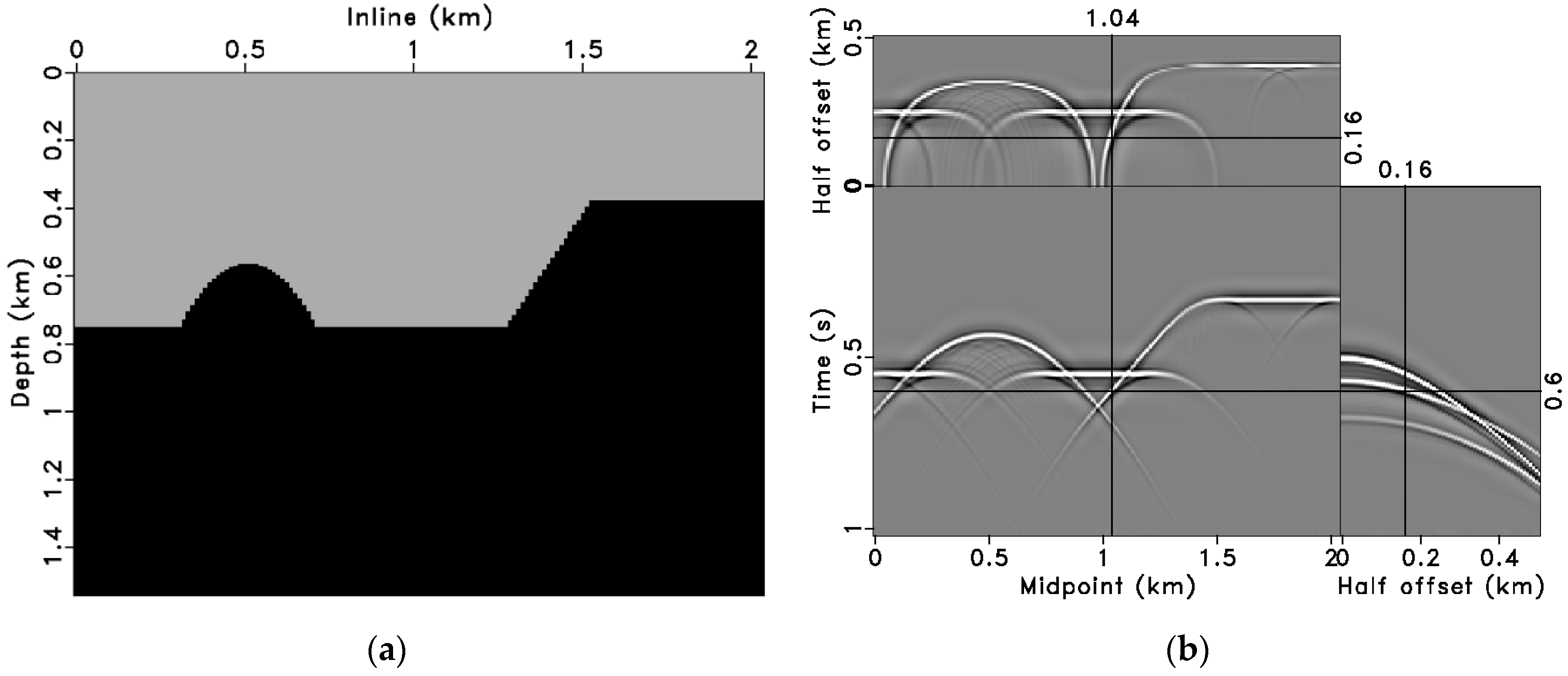
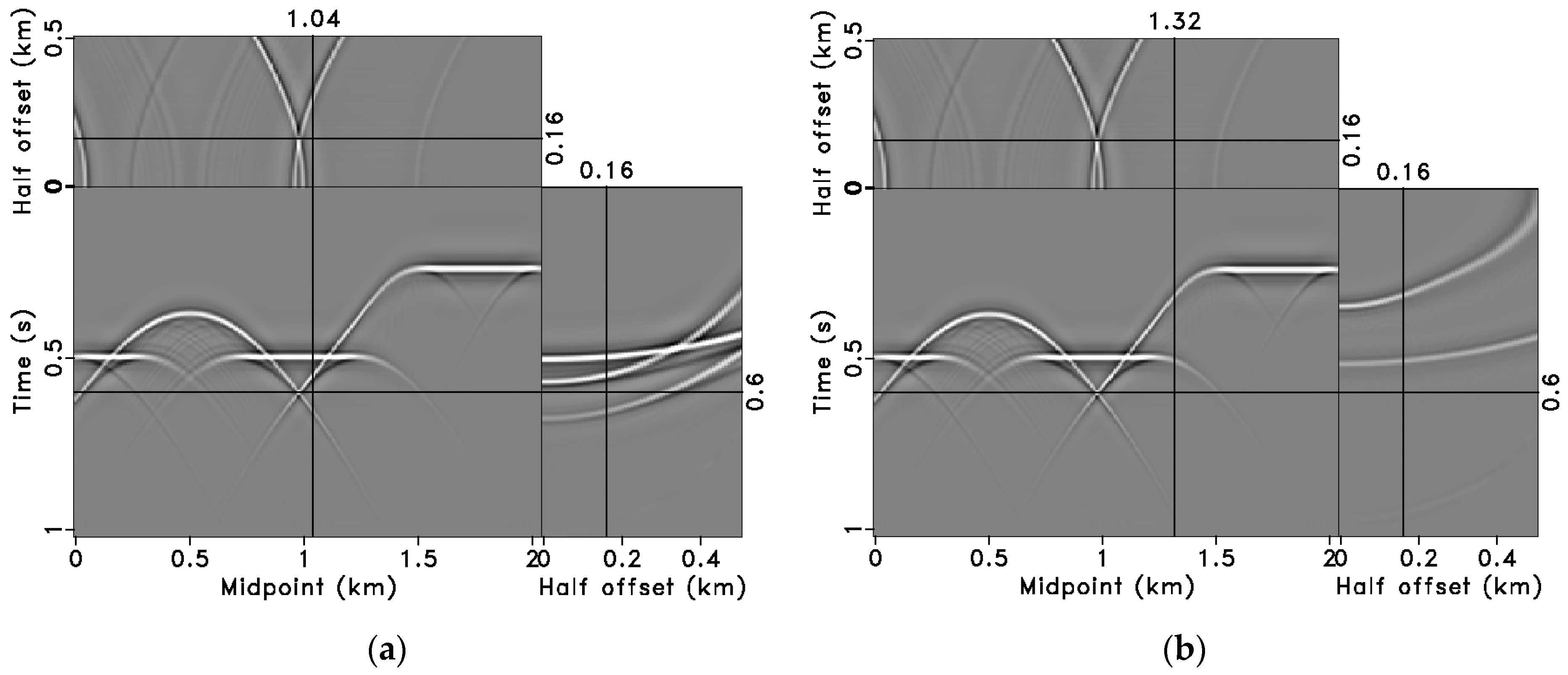
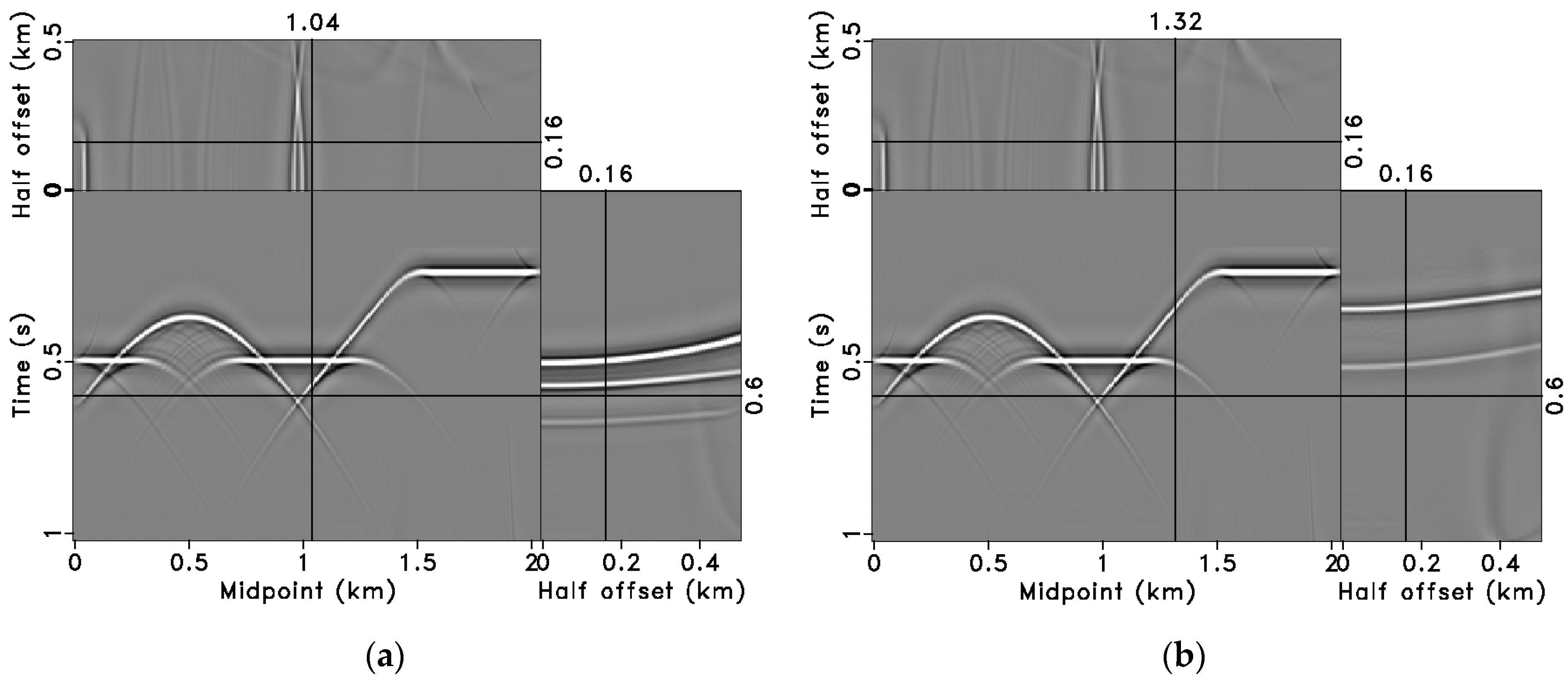
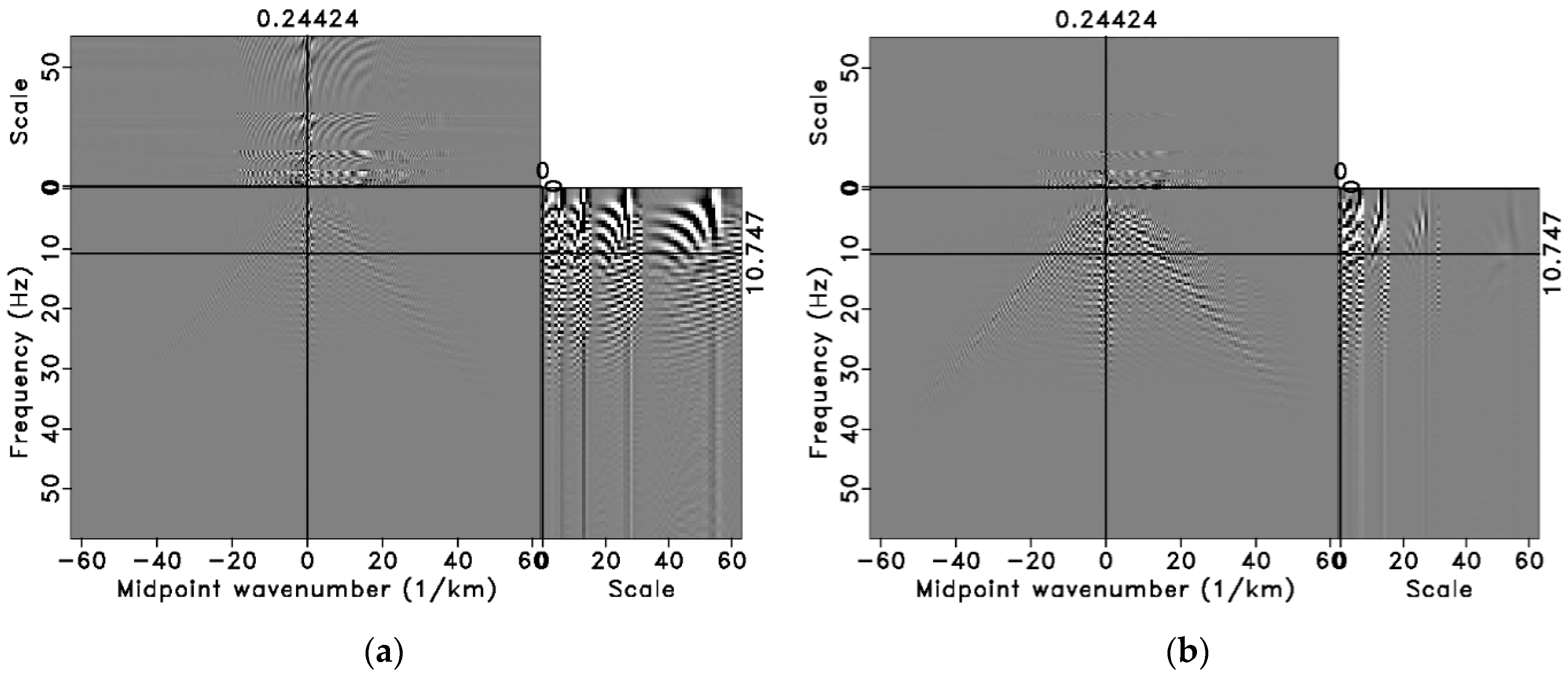
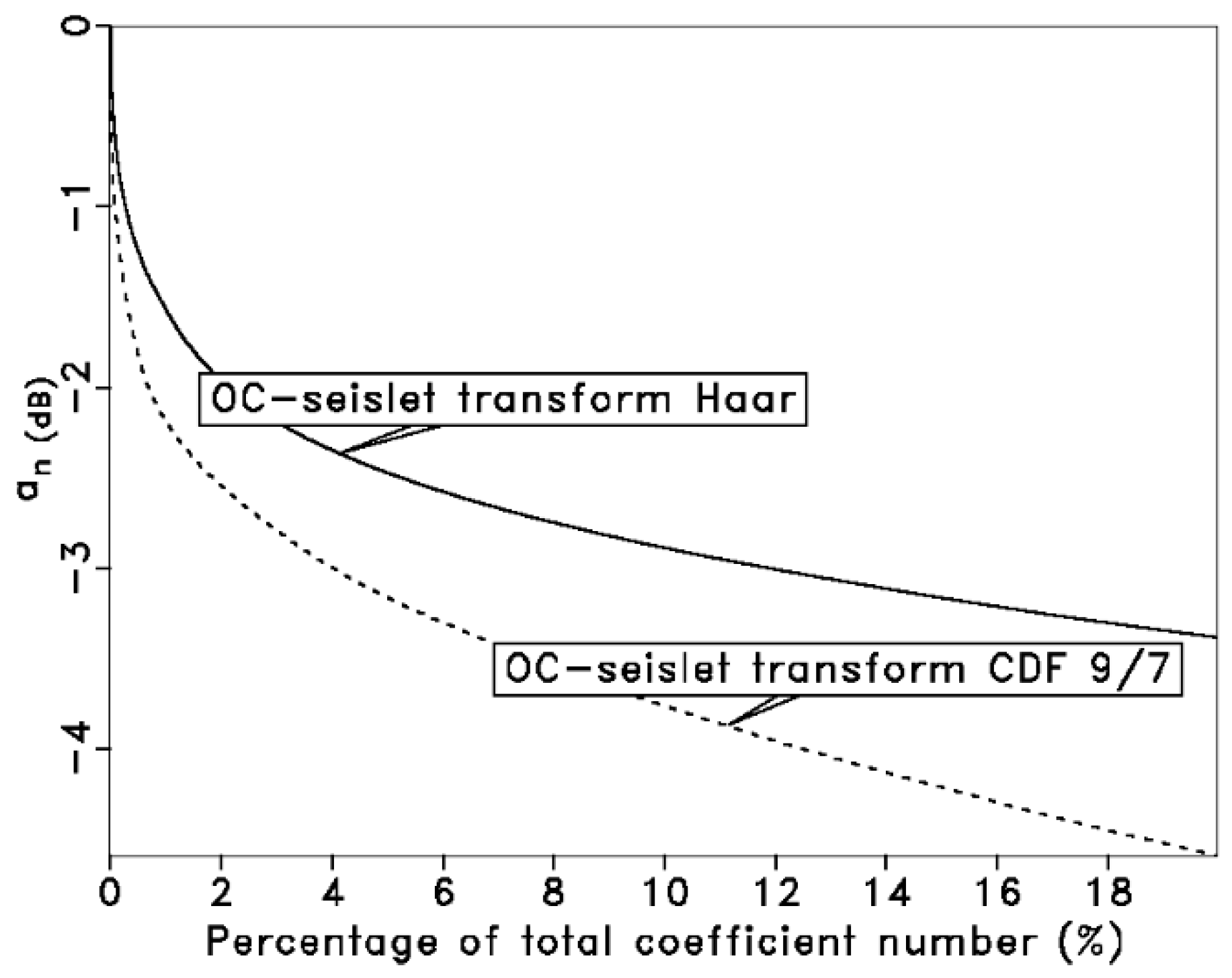
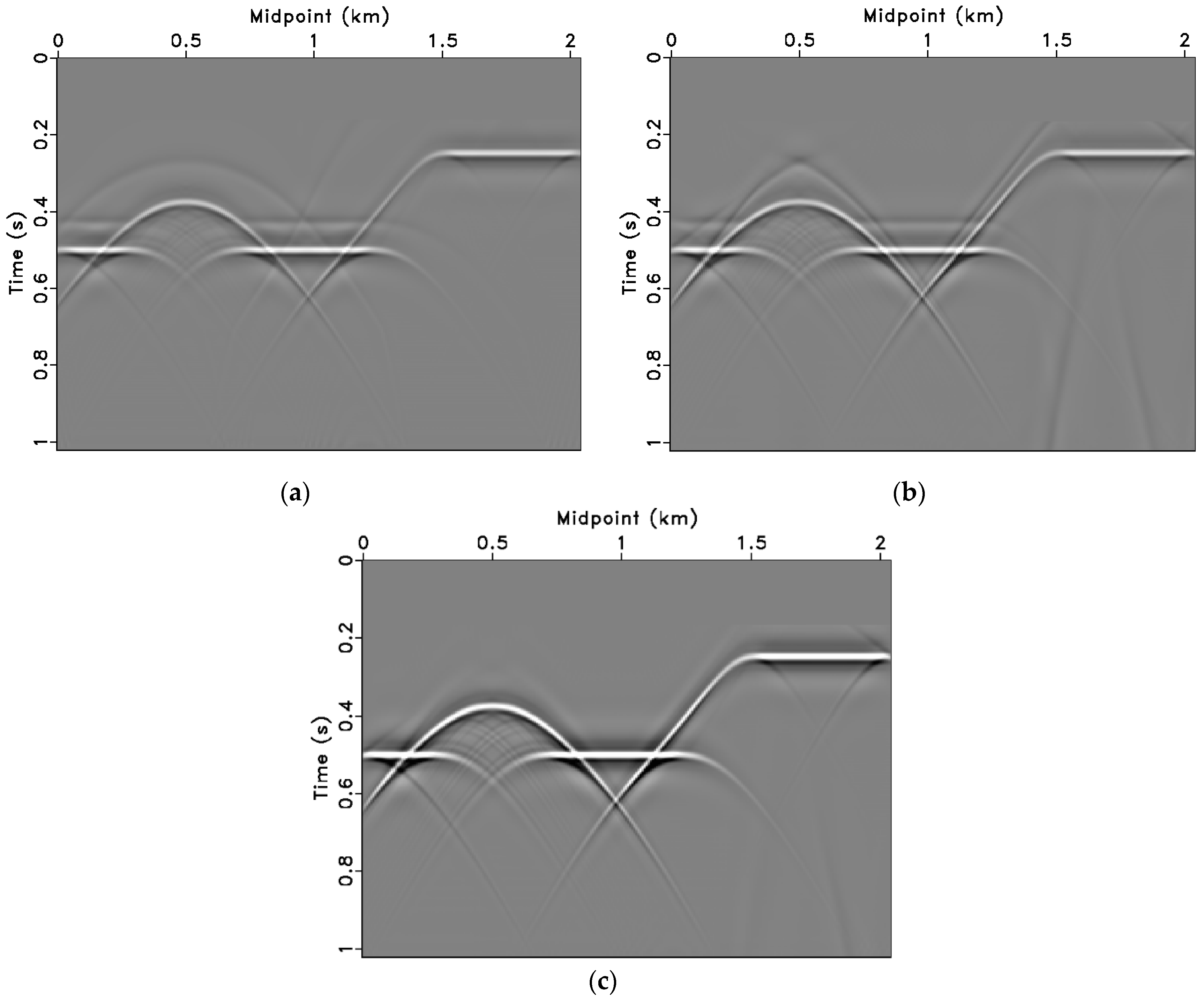
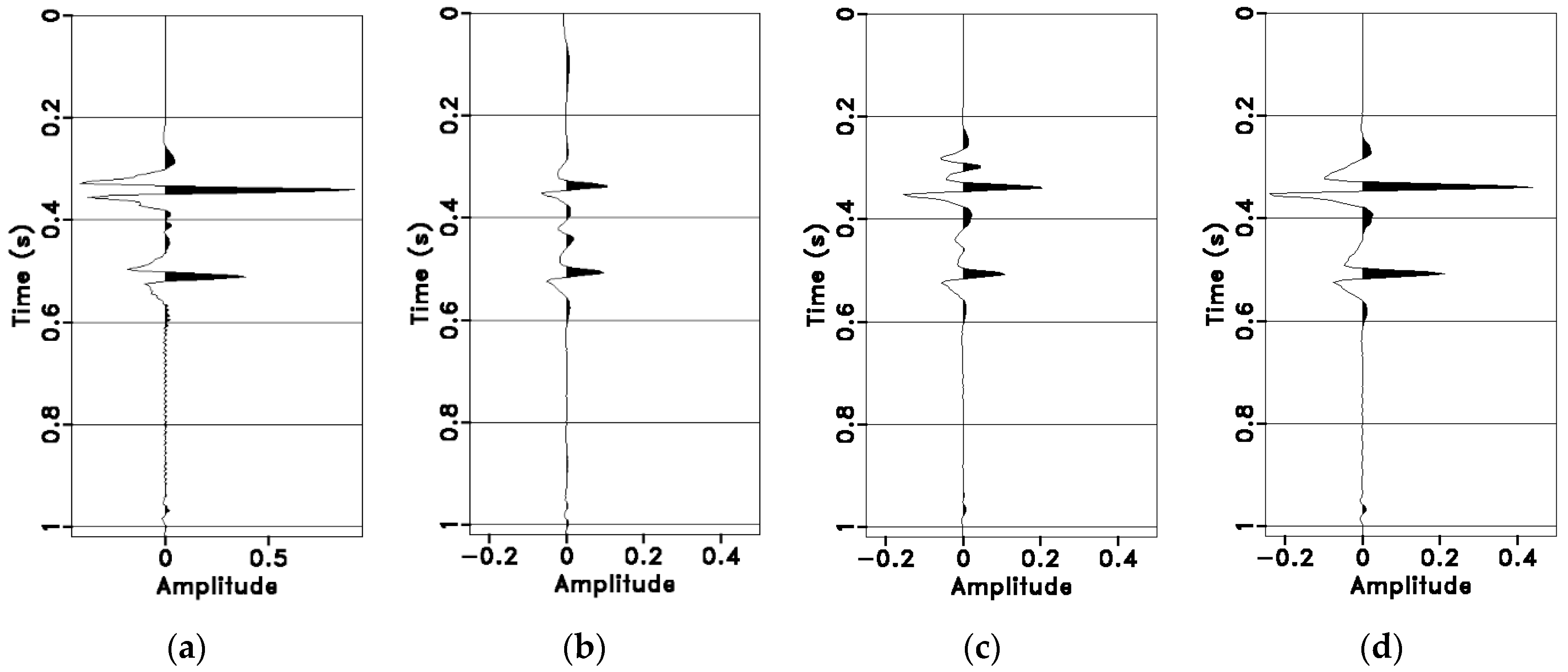
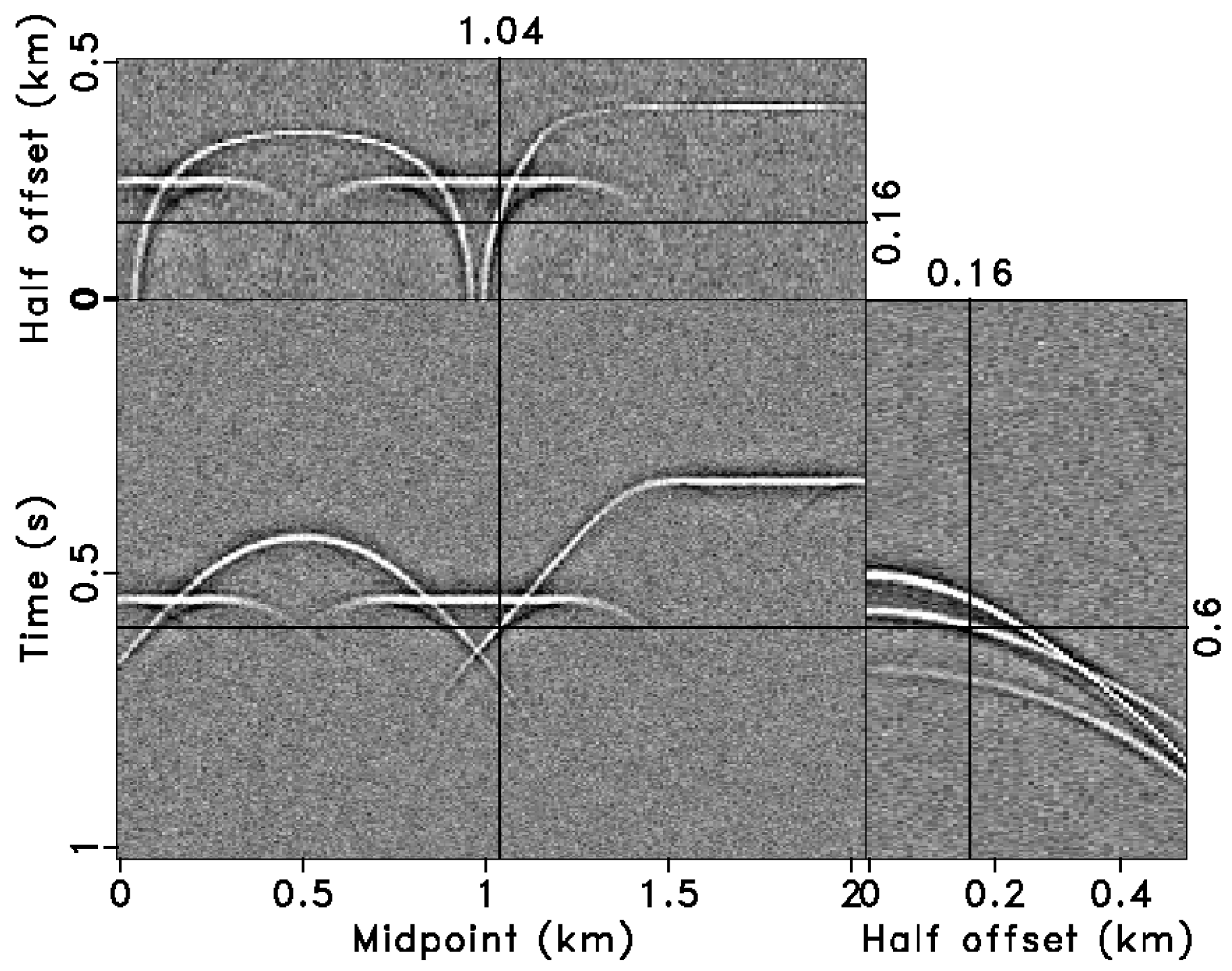

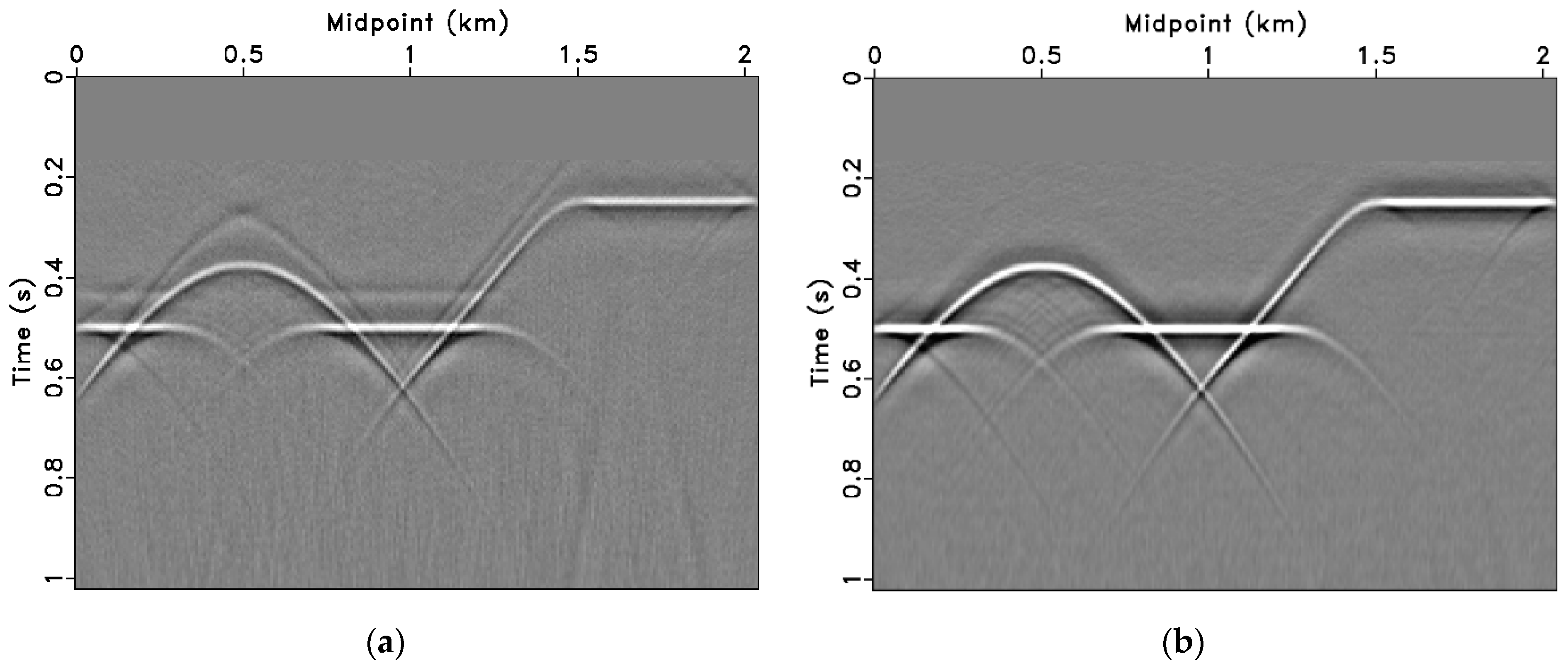
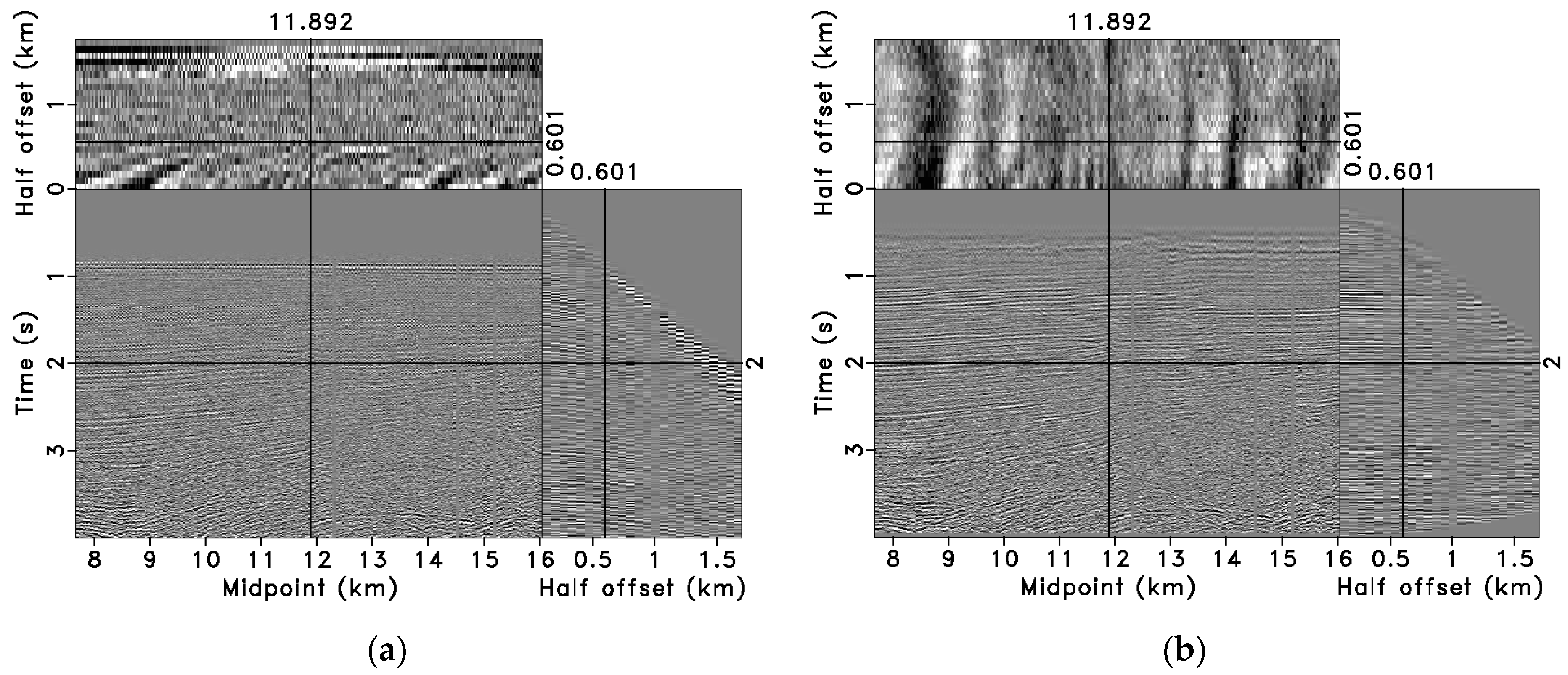
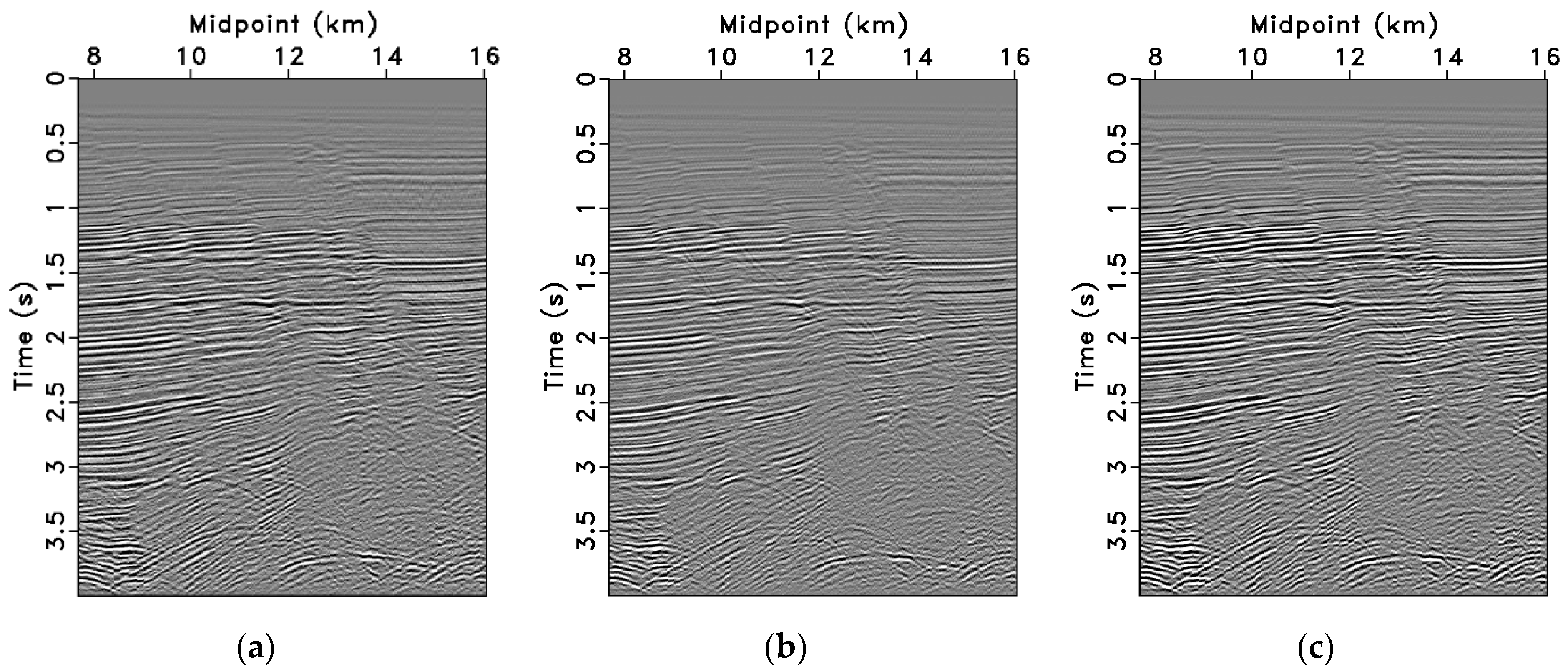
Disclaimer/Publisher’s Note: The statements, opinions and data contained in all publications are solely those of the individual author(s) and contributor(s) and not of MDPI and/or the editor(s). MDPI and/or the editor(s) disclaim responsibility for any injury to people or property resulting from any ideas, methods, instructions or products referred to in the content. |
© 2024 by the authors. Licensee MDPI, Basel, Switzerland. This article is an open access article distributed under the terms and conditions of the Creative Commons Attribution (CC BY) license (https://creativecommons.org/licenses/by/4.0/).
Share and Cite
Peng, T.; Liu, Y.; Liu, D.; Xie, P.; Chen, J. High-Fidelity OC-Seislet Stacking Method for Low-SNR Seismic Data. Appl. Sci. 2024, 14, 9973. https://doi.org/10.3390/app14219973
Peng T, Liu Y, Liu D, Xie P, Chen J. High-Fidelity OC-Seislet Stacking Method for Low-SNR Seismic Data. Applied Sciences. 2024; 14(21):9973. https://doi.org/10.3390/app14219973
Chicago/Turabian StylePeng, Tang, Yang Liu, Dianmi Liu, Peihong Xie, and Jiawei Chen. 2024. "High-Fidelity OC-Seislet Stacking Method for Low-SNR Seismic Data" Applied Sciences 14, no. 21: 9973. https://doi.org/10.3390/app14219973
APA StylePeng, T., Liu, Y., Liu, D., Xie, P., & Chen, J. (2024). High-Fidelity OC-Seislet Stacking Method for Low-SNR Seismic Data. Applied Sciences, 14(21), 9973. https://doi.org/10.3390/app14219973






